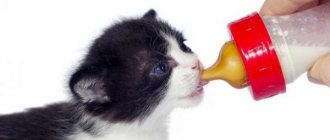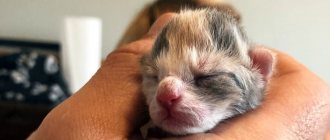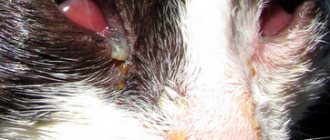| Article verified by a practicing veterinarian |
It would seem that what could be easier than determining the sex of an animal? But not everything is so simple. Even experienced cat owners sometimes cannot figure out how to distinguish a newborn cat from a cat.
There are also cases when, due to serious trauma to the genital organs or castration, it is not possible to determine the gender of an adult animal. In this article we will talk about how to distinguish a cat from a cat at any age, based not only on the appearance of the genitals, but also based on indirect signs of gender.
How to distinguish a male cat from a male cat at a young age?
How to distinguish newborns?
Determining the sex of a newborn baby is another task. But this is necessary to put up a photo of a cat for sale. After all, purebred kittens are often “armored” even before they are born. And the owner needs to know exactly which of them is a girl and which is a boy in order to provide information to future owners.
The easiest way to do this is when the babies are just born and are still wet. This will make it easier to see the place of interest. The examination of the baby should be carried out very carefully with clean hands and with the consent of the cat mother . Otherwise, she may begin to hide “her treasure” from prying eyes in all cabinets and corners.
We strongly do not recommend determining the sex of a newborn baby by palpation. Without the appropriate experience, without calculating the force of touch, you can cause irreparable injury to the baby.
How to distinguish a cat from a cat at a young age:
- Wash your hands thoroughly before examination. The immune system of newborn babies is still very weak.
- Palms should be warm and dry .
- Do not pick up the kitten while sleeping or eating.
- Calm the mother cat to avoid an unplanned attack on your person from the vigilant parent. If everything is fine and no one is against interference in personal space, you can continue.
- The kitten is carefully lifted with both hands and placed with its tummy on the palm . If the baby is very frightened and begins to struggle, strongly calls for his mother, and stroking does not help him calm down, or the mother cat becomes agitated and abandons the rest of the kittens, then it is better to reschedule the procedure. If everything is good, then we continue.
- Raising the tail, we study the distance between the anus and genitals . So, in the case of examining a male, this distance will be about 1 cm. In a female, the distance between the anus and the external genitalia (vulva) will be no more than 3 mm.
- When studying and comparing the shape of the holes, it also becomes clear that in cats it is oblong, and in cats it has a more rounded shape .
- The inspection should not last more than 1 minute . Babies freeze quickly and can get sick.
If it is still difficult to understand how to distinguish a kitten from a cat, then you can use a schematic image and put it on paper. The cat's anus and genitals will visually look like a colon. And the cat gets the letter “i”.
Characteristic features of male and female genitalia in cats
In adult males, the anus, scrotum and urethra are clearly distinguishable. The penis is located between the scrotum and the anus. In a calm state, it is a fluffy tubercle. Inside the scrotum are testicles in which sperm are formed. The scrotum is visually visible when the cat's tail is raised. In furry breeds, the organ is not so clearly visible due to their long hair. To unambiguously identify a cat’s gender, he needs to wet the fur under his tail, then the testicles will be clearly visible. In females, the only external genital organs are the urethra; besides it, the anus is clearly visible under the cat’s tail, but there are no bulges.
Cat's genitals
About sterilized animals
If more than six months have passed since the cat was castrated, then his behavior and coat are almost no different from the same signs in sterilized females. After surgery, cats are left with an empty scrotum, only by feeling it can one determine the sex of the animal.
At what age can the distinction be made more reliably?
When babies reach 10 days of age, it becomes more difficult to determine the sex, since the external genitalia are still very small and the fur interferes with vision. But there is a trick here too. At this age, boys begin to rapidly grow fur on the area of skin between the anus and genitals. But the cat doesn’t.
More reliable information about gender can be obtained from the age of one and a half months.
At this age, the baby can no longer be held in the palm of your hand, but transferred to a warm diaper or towel. Then, by lifting the tail if the kitten is standing, or moving it away if the baby is lying on its back, you can begin to study external sexual characteristics.
If the baby is scared and cowers, massage his tummy or stroke his back . The kitten's reflex will work, and it will either raise its tail (if standing) or move it to the side (if lying).
Peculiarities of behavior also appear.
Females are more affectionate and calm. Cats may begin to show aggression towards other kittens and become more independent. Kitties are big, clean people. They wash themselves more often and can wash other pets and owners.
- Determining the gender of a kitten is not only important for the owner, who gives preference to one or the other gender.
- After one year of age, cats begin to mark their territory, which many owners do not like, and cats can give birth, which also creates certain problems.
The name of the kitten is given depending on its gender. If it suddenly turns out that the owner’s beloved Fluff turns out to be a girl, difficulties will arise. An adult animal has already become accustomed to its name and is unlikely to respond to another nickname.
To more accurately determine the gender of a kitten, it is advisable to watch a training video, or invite someone you know in whose competence you are confident.
How to distinguish by the appearance of the genitals?
At the age of one and a half months, the genitals are already clearly visible. In cats, the distance between the anus and the vulva will still be small, but a gap going inward will become noticeable. At the same time, the fur of the intimate area is not very thick .
In cats, the testicles begin to visually develop and stand out , and the penile area becomes more convex. At the same time, the distance between the anus and the scrotum increases proportionally and is densely overgrown with hair.
Let's understand the terms
Both kittens look incredibly similar. These are creatures with small round ears and plush fur. Even professionals cannot always distinguish between British and Scottish Shorthair cats outwardly.
The difference is that only from a Scotsman can one get lop-eared offspring. That is, the British Shorthair is a plush, in most cases, ash-colored cat with straight ears. Her Scottish neighbor is the same, but her ears are both erect and curled. In this regard, it is called either Scottish fold (curved) or Scottish straight (straight).
The British cat is much older than its Scottish relative. It dates back to 1880, when its first representatives appeared in London. And the Scottish breed arose almost a century later. In 1961, a Scottish farmer's cat gave birth to a kitten with an atypical ear shape, which “founded” a new breed.
Note that for successful breeding of the currently popular Scottish Folds, you need to breed a straight-eared Scotsman with a fold ear. Both parents with the lop ear gene are unable to produce healthy offspring. This is due to the fact that unusual lop ears are caused by mutations in cartilage tissue and are inherited.
In order not to get too confused with breeds, passports with pedigrees and a description of the closest “relatives” of the kitten you are holding in your hands have long been invented. After all, even his straightforwardness is not a guarantee that he is a Briton. So, a British cat should have a BRI mark in its documents, an SFS one should have it, and an Erect one should have the SSS or SCS mark.
How to distinguish by other characteristics?
If you still have doubts, and you cannot visually understand how to distinguish a cat from a cat at a young age , or you need 100% information to contact the buyer, then you can use the following indirect signs to determine the gender.
Please note that the behavior of an animal is not a sign of gender . Animals, like people, have innate character traits that manifest themselves at a young age. Cats can be the most affectionate and not at all conflict with other kids. And cats can behave like real pirates, rob and take away food sources from their brothers.
The size of a newborn kitten and a kitten in the first weeks of life are also not reliable indicators of gender.
So, how to distinguish a kitten from a cat by indirect signs:
1. DNA test. An expensive pleasure, but it pays for itself when selling purebred animals. In addition to gender, they will determine predisposition to genetic diseases. Conducted in a veterinary clinic. For analysis, a scraping is taken from the inside of the cheek.
2. Coat color. By the color of the baby's coat, you can determine the gender with a high degree of probability.
- Tortoiseshell color (black and red) or tri-color (a combination of white, red and black) is typical only for girls with rare exceptions. If a male kitten is not susceptible to certain genetic diseases, then it cannot have a tricolor color. This is due to the fact that the presence of these colors depends on the X chromosome. And in order to get such a cocktail, there must be two X chromosomes, which is impossible for a healthy male.
- If your pet is red , there is a greater chance that it is a cat.
The tricolor color is characteristic of cats and is extremely rare in males
3. Thick fur in the area of the external genitalia. Males have more hair in the space between the anus and prepuce than females.
4. Shape of the muzzle. Cats have smooth and soft features on their faces. Seals have an angular muzzle shape, the bridge of the nose and cheekbones are wider.
5. Width of chest and paws. In cats they are larger and thicker.
Sexual characteristics in kittens older than three months.
By the 12th week, cats have already formed a penis, which is visible visually. Determining the sex of a three-month-old kitten is no longer difficult. In both male and female cats, the genitals are becoming more pronounced.
Females are much more harmoniously built than males and are smaller in size.
How to distinguish by other characteristics?
When it is not possible to “look under the tail,” you have to rely on behavioral and other visual (non-sexual) signs.
How to distinguish an adult cat from a cat in this case?
- Muzzle shape and body length. A cat's head is smaller than a cat's. She looks cuter and more graceful, with a slightly longer body structure. Proportionally, the cat has a larger head and a slightly shorter and more muscular body.
- Paws. Cats have longer and thinner paws, like the stem of a champagne flute. Cats have powerful and strong paws with well-developed muscles.
- By voice. Males have a lower voice timbre. Cats meow at a higher pitch. This sign is not always indicative, since sometimes males have a voice as high as that of females.
- If the animal allows itself to be stroked, you can try to feel the nipples . Unsterilized cats who have given birth at least once will have larger and more noticeable nipples. This sign is also not always reliable. Sometimes it happens that one or two nipples are missing or there are more of them than necessary; if the mammary glands are affected by any pathological process (tumors, mastitis), the animal may not allow itself to be touched due to pain.
- A way to leave marks. It is more common for cats to rub their body against various objects located in its territory. Cats prefer to leave marks by producing a special, strong-smelling secretion.
- Gait. In cats, it has a special grace. Cats don’t think much about beauty, so they feel quite wonderful, climbing from one place to another, stretching out. A dubious sign, but in general most cats are more graceful than cats. Again, if the animal is overweight, it will look like a zucchini with legs, there is no time for grace.
Why do you need to know your pet's gender in advance?
When a person decides to take a kitten into his home, he usually immediately knows whether it will be a cat or a cat. Therefore, the sooner the gender of the kittens is known, the sooner you can take the baby home and accustom him to the litter box and new owners.
Reasons why it is important to know the gender of your future pet:
- The kitten needs to be given a name. There are frequent cases when Fluff grows from Pushinka, and kittens are suddenly born to Murzik. Changing the name for an adult animal is not advisable, since the pet already responds to it.
- You should know in advance what veterinary procedure will need to be performed (castration or sterilization) and at what age.
- Adult cats and cats have behavioral characteristics, so some people prefer animals of a certain gender.
- Males of purebred animals are more expensive than females. Catteries often have pre-orders for kittens of a certain gender even before they are born.
For various reasons, people prefer animals of a certain gender.











